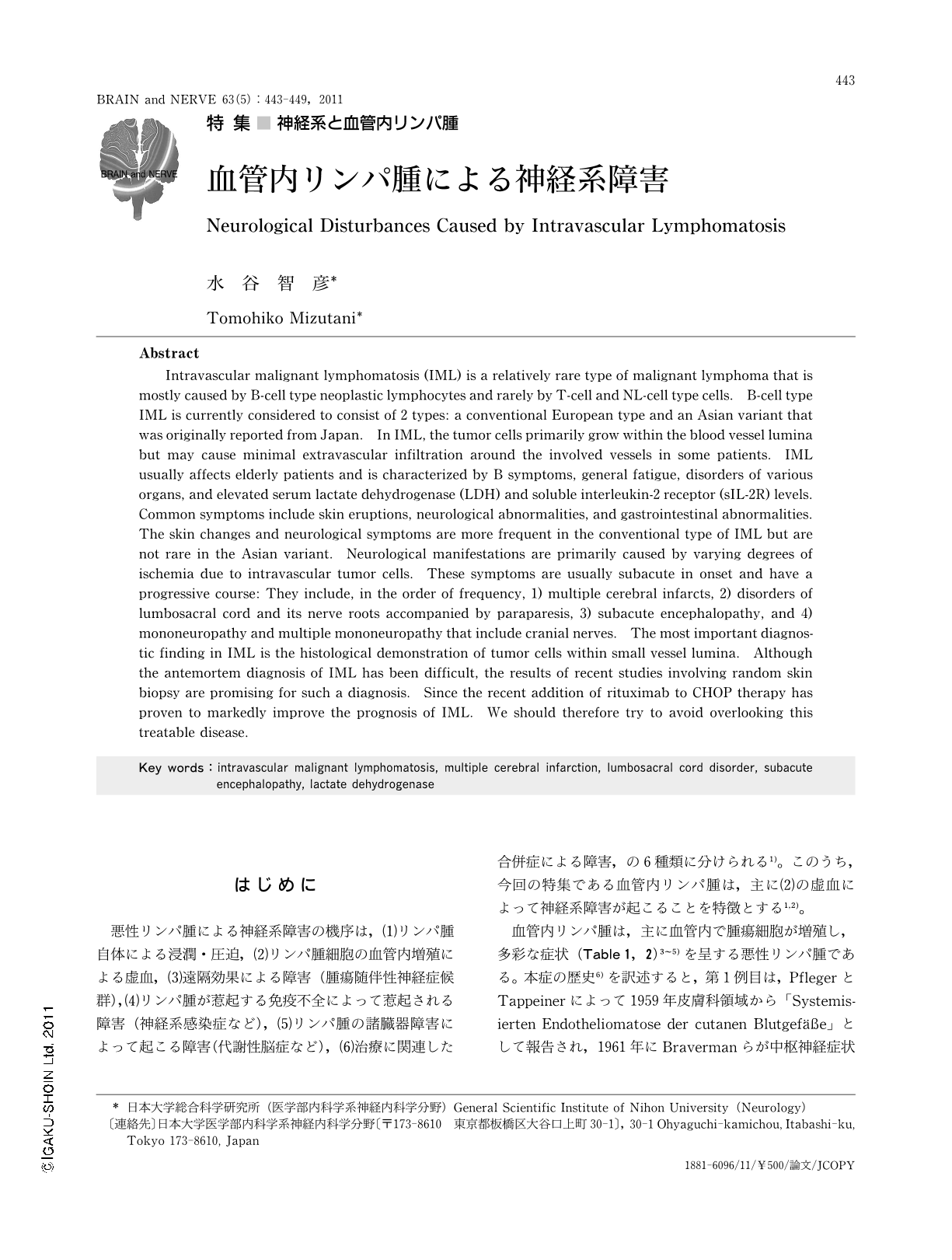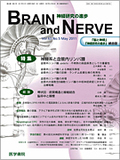Japanese
English
- 有料閲覧
- Abstract 文献概要
- 1ページ目 Look Inside
- 参考文献 Reference
はじめに
悪性リンパ腫による神経系障害の機序は,(1)リンパ腫自体による浸潤・圧迫,(2)リンパ腫細胞の血管内増殖による虚血,(3)遠隔効果による障害(腫瘍随伴性神経症候群),(4)リンパ腫が惹起する免疫不全によって惹起される障害(神経系感染症など),(5)リンパ腫の諸臓器障害によって起こる障害(代謝性脳症など),(6)治療に関連した合併症による障害,の6種類に分けられる1)。このうち,今回の特集である血管内リンパ腫は,主に(2)の虚血によって神経系障害が起こることを特徴とする1,2)。
血管内リンパ腫は,主に血管内で腫瘍細胞が増殖し,多彩な症状(Table1,2)3~5)を呈する悪性リンパ腫である。本症の歴史6)を訳述すると,第1例目は,PflegerとTappeinerによって1959年皮膚科領域から「Systemisierten Endotheliomatose der cutanen Blutgefäße」として報告され,1961年にBravermanらが中枢神経症状を呈する症例を初めて報告した。1965年にStrouthらが中枢神経病変を主体とする症例を「neoplastic angioendotheliosis」と名づけ,わが国では萬年ら7)がその第1例目を1979年に報告している。本症は,neoplastic angioendotheliomatosis, angioendotheliomatosis, malignant angioendotheliomatosis, cerebral angioendothelio-matosis, malignant angioendotheliosisなどと呼ばれていたが,intravascular malignant lymphomatosisと総称されるようになった8)。
その後,本症にみられる腫瘍細胞の大部分がリンパ球のB細胞に対する抗体でのみ染色される症例であることが判明するに及び,この病態は2001年のWHO分類では,intravascular B-cell lymphoma2,3),2008年のWHO新分類では,intravascular large B-cell lymphoma(IVLBL)としてそれぞれ成熟B細胞悪性リンパ腫の中の独立した1疾患単位として分類されている5)。従来報告されてきた血管内悪性リンパ腫症では,皮膚病変と神経症状などが臨床的特徴であったが3),近年,わが国では血液内科・血液病理の分野から「血球貪食症候群」(hemophagocytic syndrome)を主徴とする特異なIVLBL例が報告されるようになり,従来型(古典型,西欧型)に対してアジア変異型(an Asian variant)と呼ばれている3,5,9,10)。しかし,血管内腫瘍細胞は稀にT-cell type11)・NK-cell type4)であることもあるので,ここではこれらの疾患を一括して上述したintravascular malignant lymphomatosis(血管内悪性リンパ腫:IML)と呼んで話を進めることとする。
IMLは稀な疾患であり,臨床診断が困難であるため,1995年のレビュー8)では生前診断は30%と述べられている。しかし,最近の総説10)では,IMLは悪性リンパ腫の約3%を占めるそれほど稀な疾患ではないのではないかという推測もなされており,生前診断法の進歩(後述,詳細は本特集の別稿を参照)5,9,12-14)によって生前診断率は以前より高まりつつあると推測しているが,末期に診断がつく例,剖検で診断される例は現在でも稀ではない。
IMLの治療としては,IMLの標準治療である全身的化学療法のCHOP療法[シクロホスファミド+ヒドロキシダウノルビシン(アドリアマイシン)+オンコビン(ビンクリスチン)+プレドニゾロン]に加え,最近,抗CD20ヒト化型モノクローナル抗体(リツキシマブ)併用療法が行われるようになってからIMLの予後は画期的に改善されてきている5,9,10,15)。IMLの早期診断は現在でも困難であるが,本症の予後を改善させるために早期診断・早期加療が重要であることはいうまでもない。本疾患は神経系症状で発症することも多く,治療し得る疾患としてIMLを見逃さないように,本稿ではその神経学的障害を中心に概説する。
Abstract
Intravascular malignant lymphomatosis (IML) is a relatively rare type of malignant lymphoma that is mostly caused by B-cell type neoplastic lymphocytes and rarely by T-cell and NL-cell type cells. B-cell type IML is currently considered to consist of 2 types: a conventional European type and an Asian variant that was originally reported from Japan. In IML,the tumor cells primarily grow within the blood vessel lumina but may cause minimal extravascular infiltration around the involved vessels in some patients. IML usually affects elderly patients and is characterized by B symptoms,general fatigue,disorders of various organs,and elevated serum lactate dehydrogenase (LDH) and soluble interleukin-2 receptor (sIL-2R) levels. Common symptoms include skin eruptions,neurological abnormalities,and gastrointestinal abnormalities. The skin changes and neurological symptoms are more frequent in the conventional type of IML but are not rare in the Asian variant. Neurological manifestations are primarily caused by varying degrees of ischemia due to intravascular tumor cells. These symptoms are usually subacute in onset and have a progressive course: They include,in the order of frequency,1) multiple cerebral infarcts,2) disorders of lumbosacral cord and its nerve roots accompanied by paraparesis,3) subacute encephalopathy,and 4) mononeuropathy and multiple mononeuropathy that include cranial nerves. The most important diagnostic finding in IML is the histological demonstration of tumor cells within small vessel lumina. Although the antemortem diagnosis of IML has been difficult,the results of recent studies involving random skin biopsy are promising for such a diagnosis. Since the recent addition of rituximab to CHOP therapy has proven to markedly improve the prognosis of IML. We should therefore try to avoid overlooking this treatable disease.

Copyright © 2011, Igaku-Shoin Ltd. All rights reserved.


